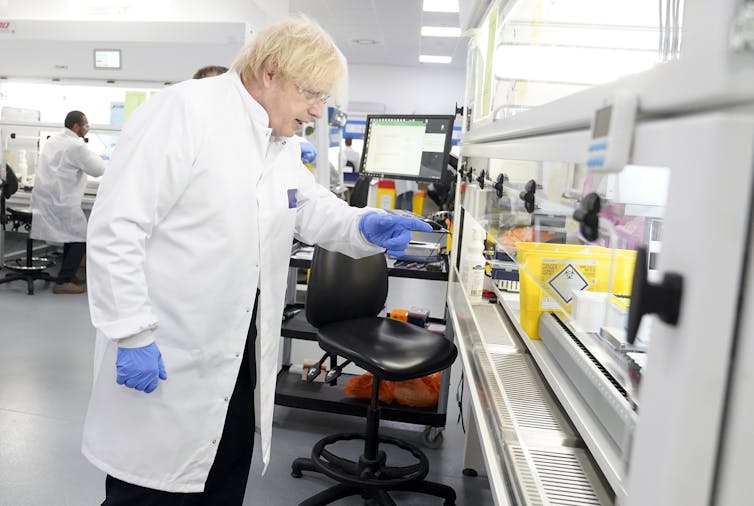RossHelen/Shutterstock
It was March 2020, and my plans to start a new cancer research project in Boston were called off for the same reason everything else was grinding to a halt: coronavirus. Facing indeterminate months confined to my sofa, I signed up to a call for scientist volunteers circulated by the University of Cambridge.
The requirements weren’t very specific, and after almost losing hope that I would ever hear back, I received a phone call inviting me to assist in the ramp-up of the UK’s testing capacity.
Three days later, at the end of March, I arrived with a handful of other volunteers at an industrial estate near the town of Milton Keynes, outside London.
Building a megalab
On the outside, the testing centre resembled a warehouse more than a lab, but an impressive management team including many of the UK’s leading scientists had already been assembled. The team leader, who had arrived the week before, introduced us to the task at hand: create a facility that would be the backbone of the UK’s testing strategy.
At this point, it seemed like a far-fetched idea to me. The “lighthouse” lab to process the bulk of the coronavirus test samples hadn’t even been constructed and unboxed equipment was piling up. There was no indication this would soon become the largest coronavirus testing site in the country.
From the start, one of the biggest challenges was in gathering equipment. Seemingly difficult tasks turned out to be straightforward, whilst trivial ones became surprisingly intractable.
Complicated, expensive machines donated from institutes all around the UK were installed within a couple of days; manufacturers massively ramped up production of sophisticated test reagents and we were able to build up our stocks.
But something as seemingly trivial as a shortage of pipettes threatened to stall the whole operation, as thousands of tests waited to be processed. In an emergency like this it was handy to have a direct line to institute heads around the UK who were eager to help. One more call and an army truck with dozens of pipettes and other equipment arrived within three hours.
In the end, the collaboration between permanent staff, scientists, external institutes, private companies and the armed forces made it possible to set up a working lab within a matter of days.
A motley crew of scientists
The volunteering scientists in my cohort were a diverse crew: most of us had PhDs and had spent years in scientific research, but we initially shared a common concern that few of us had experience dealing specifically with coronaviruses. My own expertise investigating the molecular causes of Parkinson’s disease and cancer seemed a far cry from viral diagnostics.
As it turned out, there was little cause for concern – the coronavirus test is actually quite straightforward. At its heart lies the Polymerase Chain Reaction (PCR) method, arguably one of the most widely used techniques in molecular biology labwork and a procedure undergraduates students learn as part of basic training.
In a PCR test, the genetic material of the virus is mixed with enzymes that can build and replicate viral DNA. Short DNA sequences called “primers” are then added. In a positive test the primers “recognise” viral genes and initialise their replication. Hence, when we see more DNA being produced, we know that it must belong to the Sars-CoV-2 virus, and the PCR test returns a positive result.
Read more:
COVID-19 tests: how they work and what’s in development
All of the newly arriving scientists had used the PCR technique in their own research many times before and it quickly became apparent that coordination and good management was a greater challenge than technical knowledge of coronavirus biology if this unprecedented undertaking was to succeed.
Every week, dozens of new volunteers were recruited from top universities and institutes all over the UK. Some of us stayed in pre-arranged hotels nearby, others commuted from our home towns. Each cohort received a week of intensive training and by the following week were themselves training the next intake of volunteers under the supervision of a shift leader.
Within two weeks, the site had changed beyond recognition. New labs had been fitted, robots had been installed, dozens of new hires were being trained every week and my initial worries started to dissipate. I began to think, “We can actually do this!”
Scaling up
With essential equipment installed, it was time to scale up. To an experienced scientist, performing a single PCR test is straightforward, but running tens of thousands of tests a day is a different story.
Time and again simple considerations turned out to be the most vital: “What’s the best way to extract the sample from its packaging?”, “Should the barcode be scanned before or after the sample is taken out?”, “At what moment should the pipette be mounted with a pipette tip?”
Feeding a robot with samples turned into a process with all the efficiency of a Formula 1 pit stop. One operator takes out the old samples, a second replenishes test reagents and a third loads another 94 samples – 10 seconds, done. Soon we had an integrated workflow of dozens of steps running in perfect orchestration.
While speed is important, precision is vital. A false negative result could see a nurse with COVID-19 going back into a care home to infect dozens of vulnerable patients; a false positive might see a healthy doctor sent home from ICU to self-isolate for a fortnight, or a key worker sending half their company into quarantine for no reason.
To prevent this, a sample must be tracked electronically and on paper at every stage. Every intervention by a scientist must be supervised by another to help prevent human error.
As our team grew, strict training routines needed to be established with clear rules. How do you write a “1”, an “I” and a “7”? Is this a “5” or an “S”? How do you distinguish an “O” from a “0”? Lecturing experienced professionals about how to write numbers and letters made me feel absurdly pedantic, but it quickly became clear that common rules have to be followed religiously to minimise all possible sources of error.
A month in, we had enough volunteers to work 24/7. I lost track of the time of day and the days of the week. The daily routine was governed by the mantra of Tedros Ghebreyesus, the head of the World Health Organization: “Test. Test. Test.”
Back in the first week, the manual sample handling process allowed a us to process a couple of hundred samples. With more volunteers coming in, this increased to a couple of thousand, and when we roped in robots to help, it quickly reached tens of thousands of processed tests per day.
Just like the spread of the virus we were competing against, our capacity was growing exponentially. What would normally have taken months or years to establish, now took days or weeks.
The eye of a political storm
The progress on testing has received a lot of bad press and many of us at the test centre felt we were being made personally responsible for hitting government targets. This added pressure caused frustration, especially when everyone gave their very best to make this undertaking a success.

Number 10, CC BY-NC-ND
We need to put things in perspective. From a starting point of zero, within weeks, the joint efforts of hundreds of volunteers allowed the lab to process more than 30,000 tests per day – or one test every three seconds.
This put us in a position where the processing of COVID-19 tests was no longer the limiting factor of the testing initiative and soon there has been hardly a day where our testing capacities were being used to the full. The debate now should be less about the available testing capacity and more on how to make best use of what is available.
The privilege of a lifetime
Most of the original crop of recruits have finished their time at the testing centre and have gone back to their labs to continue their previous research. What remains as one of the most positive takeaways from my perspective is that, despite the challenges and the country’s seeming divisions, it is still possible for us to rally around a common goal. Volunteers joined the testing initiative from all corners of the country, many of them from Europe and beyond living and working in the UK, eager to help out in the common effort to fend off the invisible enemy.
The work of these people has saved lives. It was my great privilege to have been part of this collaboration.
![]()
Tobias Wauer does not work for, consult, own shares in or receive funding from any company or organisation that would benefit from this article, and has disclosed no relevant affiliations beyond their academic appointment.











